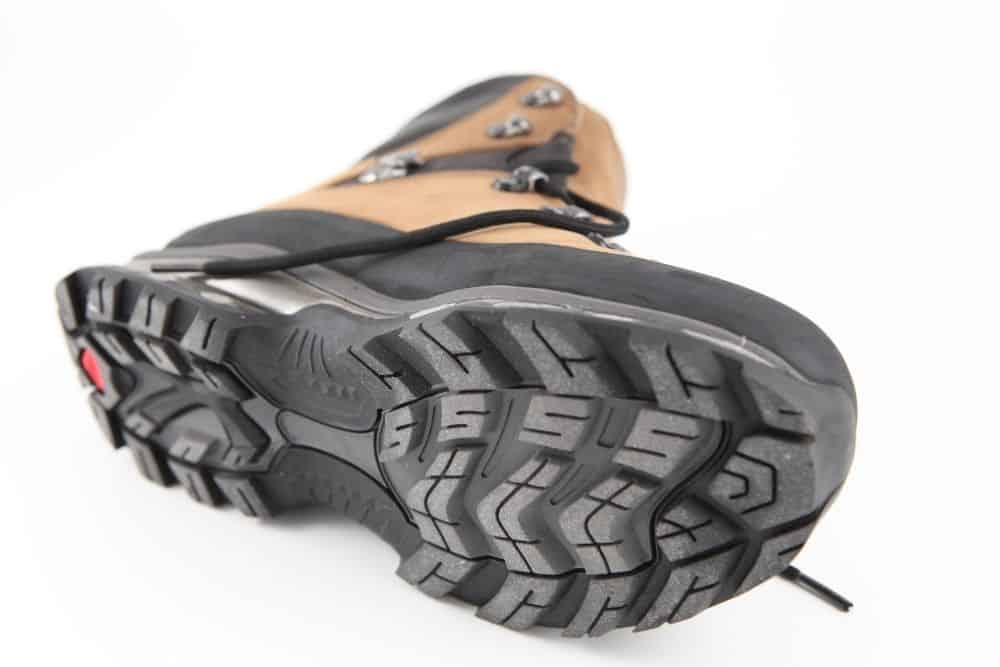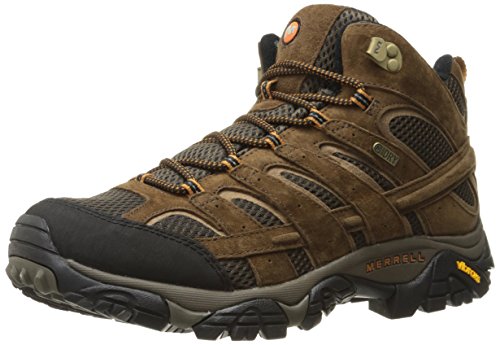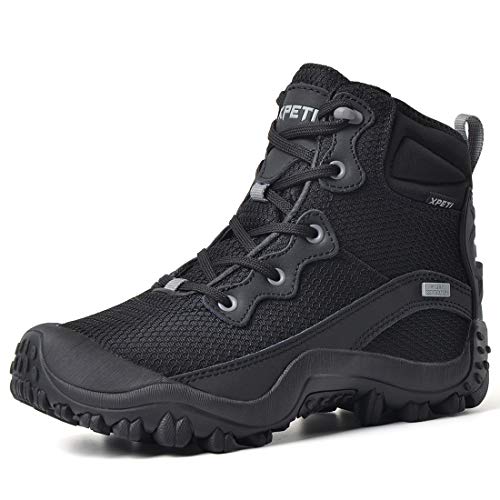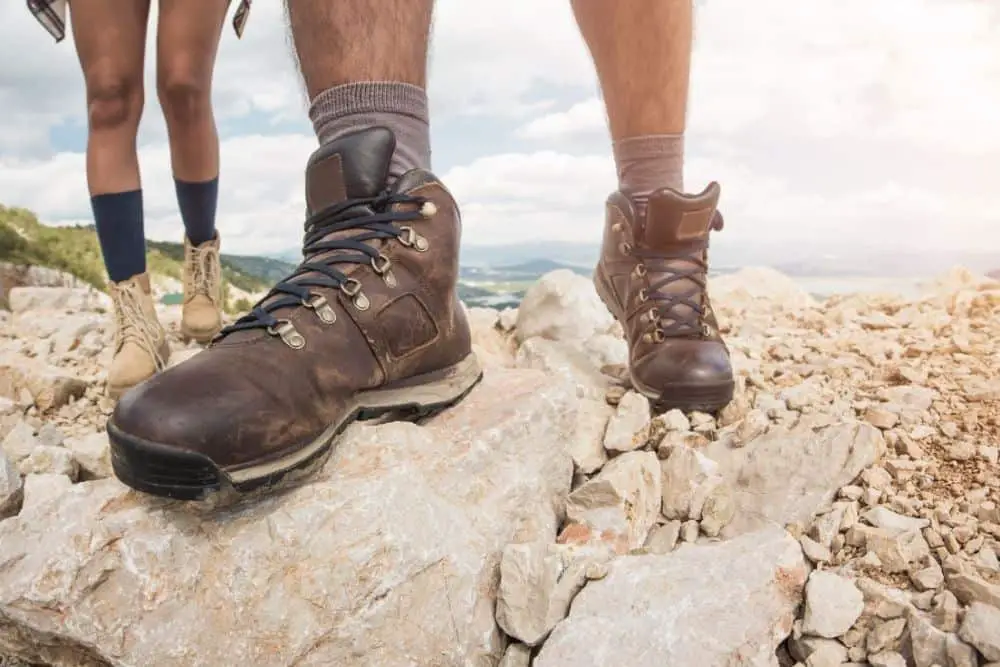Hiking is fun but things can get really sour if you are not properly protected. Throwing yourself out into the wild means you are going to be fighting against the weather, plants, animals, and the terrain—and they will win unless you are adequately prepared.
One of the areas that needs adequate protection during a hike is the ankles, which is the meeting point between the lower leg and the feet. The ankles are flexible and if you will be doing a lot of climbing or hiking on uneven surfaces, you need adequate ankle support for stability as well as to avoid injuries.
Considering the delicate nature of the ankles has left many enthusiastic hikers asking if hiking boots provide ankle support or protect the ankles. Whether you will get ankle support from your hiking boots or not will depend on the build of the hiking boots.
The amount of protection you will get from a hiking boot will depend on the outsoles, midsoles, height, and material of the boot—but that is if you have a healthy ankle in the first place. For those who already have ankle injuries, hiking boots alone may not be enough to protect their already delicate ankles.
Most hiking boots use thick leather and a tall design to keep the ankles upright and aligned when you are out on a rough trail. But, do you even need ankle support when out on a hike?
We are going to be looking at all the features that you should look out for when searching for hiking boots with ankle support.
Contents
Do hiking boots provide ankle support?
Hikers who prefer trail runners over hiking boots are always locked in a debate whenever the topic of ankle support comes up. Those in favor of trail runners because of their light nature will tell you that hiking boots don’t provide ankle support.
However, hiking enthusiasts that favor the use of hiking boots will tell you they mostly do so because of the protection they offer their ankles. So, who is wrong and who is right?
While hiking boots provide ankle support, the level of support you will get will depend on some of the features of the boots. Nevertheless, it will be a myth to think that hiking boots will completely eliminate the risk of ankle sprain or twist. Yes, they can minimize the risks but not totally eliminate them.
Hiking boots are usually heavier (having an average weight of 2 pounds) with thicker and higher outsoles so any time you step on uneven ground or attempt a climb, you will feel all that weight on your ankle.
It is common knowledge that footwear with a low center of gravity, thinner and flexible soles should provide better tactile feedback and connect you better to the ground allowing you to adjust your strides to avoid misplaced footfalls which are most implicated for ankle sprains.
We know that hiking boots lack these features because of their thicker and studier outsoles. Hiking boots may do a bad job at the soles but there are studies that suggest the use of high-top shoes can prevent ankle sprains because of their ability to restrict extreme motion ranges.
But, does that mean that hiking boots are useless? Certainly not! Apart from offering better protection from spines and sharp rocks than trail runners, high-cut hiking boots biomechanically support your feet and ankles in myriad ways when you hike certain terrains.
To evaluate and better appreciate the level of ankle support you can get from hiking boots, we have to look at the different parts of hiking boots.
Outsoles

The flexibility and thickness of your outsoles will impact your ankle in different ways. Hiking boots with the right outsoles will protect your ankles from shocks and reduce the risk of twists or sprains.
Interestingly, what many articles on this topic will not tell you is that the right choice of outsoles will depend on the health of your ankle. Those with healthy ankles should choose boots with thin and flexible outsoles for better feedback from the ground which allows them to better align their steps.
On the other hand, those with weak ankles or people who have hurt their ankles before need boots with thick and sturdier outsoles to absorb the shocks from the ground—particularly when hiking hard and rough trails. You want to shut off shocks before they get to your ankles.
Most hiking boots’ outsoles come with deep lugs and specialized grooves for improved grip. The combination of these factors keeps your feet firm on wet or slippery surfaces.
This is an invaluable feature considering the fact that a vast majority of ankle sprain arise from slipping and falling while on a trial. While stiff-soled boots may seem better for shock absorption, you need to keep the following in mind;
- They restrict the natural movement of the feet which can make them uncomfortable
- Walking on uneven terrain may feel uncomfortable because the soles cannot flex to accommodate the unevenness
- Stiff outsoles are often heavier and you will feel the pressure on your ankles
Midsoles
The cushioning provided by the soles is further enhanced by the midsoles. The midsoles give the boots a bouncy effect that keeps shocks and tension away from your ankles and lower leg muscles.
A cushioning system functions by extending the duration of an impact, thus, lowering the shock load that gets to the musculoskeletal system. It is estimated that the reaction force of the ground is 1.25 times that of the body weight when walking—but can reach 2 to 3 times when running.
The midsoles provide a cushion to dampen the impact of this ground force from reaching your body. In other words, it limits the amount of force that gets to your ankles.
For best ankle support, it would be a smart idea to go for hiking boots with thick and responsive midsoles. Also, when choosing midsoles for ankle support, make sure they have good padding to make it easy for you to stand on rocky or rough surfaces without feeling all the spikes under your feet.
When hiking rough or rocky terrain, you need to be picky about the midsoles of your boots. In the past, the material for cushioning was rubber. However, that has changed in recent years as manufacturers are now experimenting with gels, pads, fluid, and air soles to provide a cushion.
Arch support

The arch is the distance between the heel and the ball of the foot. This is the area that receives most of the impact from rough surfaces and spiky rocks which often leads to frictional injuries.
Hiking boots with flexible arches do a better job in ankle support than those with stiff arches, especially when combined with a good shank. The shank will be able to provide stability and balance.
In general, good arch support helps you to maintain good walking posture because bad posture will most definitely put more pressure on your ankles.
Upper
In terms of upper or shaft, hiking boots can be grouped into three distinct categories namely low-cut, mid-cut, and high-cut. All of these refer to the height of the hiking boot upper and they all affect your ankle in different ways.
Low-cut

If you want to train your ankle to get used to rigorous and sudden movements, a low-cut upper would be a great choice because it sits below the ankles to provide a cushion while giving your ankle the freedom to move freely.
Also, low-cut hiking boots are usually lighter in weight compared to high-cut hiking boots. The lower the weight, the lower the pressure on your ankle and feet.
Mid-cut

The mid-cut hiking boots lie just on the ankle and will give stability to your ankles. Their benefits are more felt on backpacking trips.
Since they cover the ankles, you will be protected from the graze or prick of sharp rocks and twigs on your ankle. This property also protects your ankle from inflammation when you strike it on a rock by accident.
High-cut

The high-cut hiking boot offers the best ankle support as it rises several inches above the ankle. The lacing system also makes it tighter around the ankles to keep them firm and avoid sudden movements.
One of the biggest setbacks with high-cut hiking boots is that they are too restrictive. The feeling will be worse if they are made of thick leather.
While this restriction may have some positive impact on the ankles it will also make it difficult for you to hike at a fast pace. However, high-cut hiking boots cover the entire ankle and a bit of the lower leg giving you maximum protection from rock and twig scrapes.
It will also provide some cushion that will dampen the effect of any sudden impact or strike on the ankle.
Are hiking boots good for weak ankles?
While those with healthy ankles have the luxury of wearing any hiking boots, those with weak ankles have to be pickier when it comes to choosing hiking boots. If you already have weak ankles, your best bet would be to go for a leather hiking boot with a tall design.
Tall or high-cut hiking boots made with heavy leather material should be able to keep your ankles aligned upright even on rough surfaces. However, even this may not be enough for weak ankles.
Does that mean you should never attempt to hike if you have weak ankles? Far from it! However, you may need to take extra precautions with your tall hiking boots to protect your ankle.
If you must use just any hiking boot with a weak ankle, you need to take some precautionary measures to avoid exacerbating your condition. Below are some of the steps you can combine with hiking boots to provide adequate protection for your weak ankle.
1. Use of ankle brace
- An ankle brace that moves with you: Invest in an ankle support that will last. Zenith has developed...
- Ankle pain, be gone: Proven to reduce or eliminate ankle pain caused by sprains, tendonitis and...
- Stay on your feet: We specifically made this brace to perform well in ANY activity, including:...
Last update on 2023-11-11 / Affiliate links / Images from Amazon Product Advertising API
Ankle braces will provide better support for your weak ankles when you are out on a hike. They wrap snugly around your ankle to restrict their movement thereby helping to prevent sprain.
Some ankle braces may be bulky which means you will struggle to fit them into high-cut hiking boots. However, you should experience minimal problems combining them with trail runners or low-cut hiking boots.
2. Wear compression socks
- QUICK RELIEF WITH NO MOTION RESTRICTION for Plantar Fasciitis, Achilles Tendonitis, Heel Spurs,...
- NO RISK PURCHASE: We commit no-hassle returns on our Compression Ankle Socks for Women & Men if...
- EASY TO WASH & MAINTAIN: Physix arch support socks wash well manually or by machine and dries...
Last update on 2023-11-11 / Affiliate links / Images from Amazon Product Advertising API
Wearing compression socks with ankle support will bring a lot of relief to your ankle and prevent further injuries. Using compression socks will also bring you relief if you are already experiencing inflammation on your ankle.
Compression socks are not as restrictive as braces. Also, they are thinner and more comfortable to wear with all types of hiking boots.
3. Stay hydrated

Soft tissues are more prone to injuries when they are dehydrated. Therefore, it is important for those with weak ankles to stay hydrated at all times—and we are not just talking about when they are on a hike.
4. Strengthen your ankles for the hike
It is always a smart idea to know the terrain that you will be hiking and prepare adequately to face the challenges that it throws at you.
One of the ways to prepare your ankle for rough terrain is through ankle exercises—and you should never wait to develop weak ankles before you start trying ankle exercises.
Sitting on an elevated surface, raising your legs off the ground, and rolling your ankles for 10 to 30 minutes can do a lot of good to them. Also, if you are new to hiking, always start with a shorter distance with a fairly even surface and work your way up.
Always do your hiking simulation exercise on a surface that has a close resemblance to the surface that you will be hiking.
Do this several times every day before going for the real hike. This simulation helps to strengthen your ankles and prepare them for what comes next. Also, it will give you an idea of the limit your ankle can go.
Conclusion
Inasmuch as the high-cut ankle boots are promoted as working like the cast used in a medical setting during leg injury recovery, the reality is that they are nothing alike.
Any boot that will have cast-level ankle support will be highly restrictive such that it will make hiking painfully difficult—and the feeling will get worse anytime you want to increase your pace.
While hiking boots may provide some level of ankle support, you should never overestimate the amount of protection you will get from there.
In other words, regardless of the type of boots you are rocking on your hike, always maintain awareness of your surroundings and take cautious steps when you are on uneven ground.
When it comes to hiking boots, there is no one-size-fits-all. A boot that may seem perfect for one hiker may be an awful choice for another.
Always ensure that the hiking boot that you choose for your hike fits snugly on your feet because happy feet are equal to a happy hike.



